This first table shows the Nemesis 360 GTS X-Flow’s Watts/10 Delta Temp numbers in a quick glance chart format.
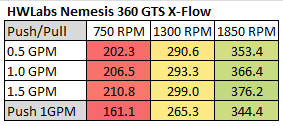
Using the data compiled from the thermal testing I have compiled the following tables in an attempt to show other ways of how the GTS X-Flow’s performance varies against itself at the flow rates and fan speeds tested. Effectively these show percentage gains relative to a reference point. It’s an interesting way to show gains/losses while changing a variable.
First let’s focus on 1300 RPM as our reference and see how much gain or loss in performance we get by changing fan speed.
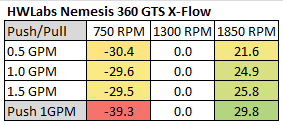 Rather even percentage differences here indicate the tuning of this rad is well balanced. The exception here is the Push Only 750 RPM which we actually did a Re-test on because the data stood out as an anomaly from the initial testing. Re-Tesing produced a result which was very similar to the first tests.
Rather even percentage differences here indicate the tuning of this rad is well balanced. The exception here is the Push Only 750 RPM which we actually did a Re-test on because the data stood out as an anomaly from the initial testing. Re-Tesing produced a result which was very similar to the first tests.
Let’s now focus on the Push/Pull data looking first at the changes from 1.0 GPM:
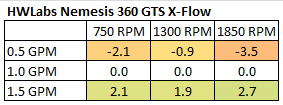
With only slight percentage changes when changing the flow rate we conclude that flow rate is not a determining factor for performance on the GTS X-Flow.
How about we combine both flow rate and fan speed as reference points and have a look at 0.5 GPM & 750 RPM as the reference point.
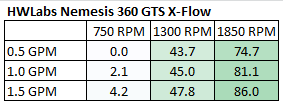
Lastly, we change the reference and choose the center 1300 RPM and 1.0 GPM as our reference point to show both effects concurrently:
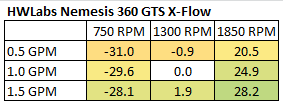 So from the data above we can get a very good idea of how the 360 GTS X-Flow radiator performs relative to itself. But there is a large selection of 360mm radiator models to choose from, released from numerous manufacturers. So, we need to start comparing performance between them.
So from the data above we can get a very good idea of how the 360 GTS X-Flow radiator performs relative to itself. But there is a large selection of 360mm radiator models to choose from, released from numerous manufacturers. So, we need to start comparing performance between them.
Push Only Data vs Competition
Let’s focus on the Push Only results for now and come back to the Push/Pull data later. While for Push/Pull we tested three flow rates, the Push Only testing was conducted only at 1GPM in order to save time. For a comparison vs. thicker radiators make sure to check out the Extreme Rigs Rad Round Up.
Let’s start with 750 RPM and see how it compares to the Slim Rad competition:
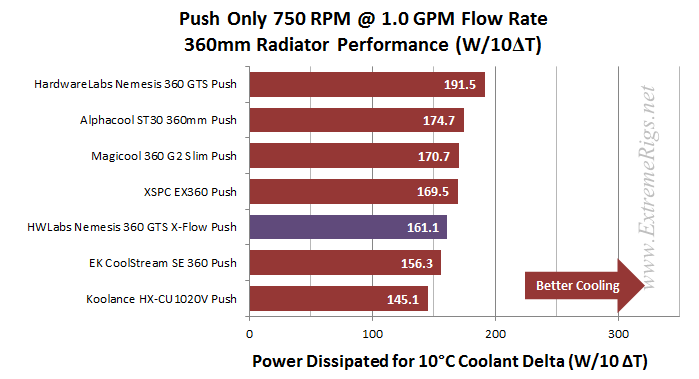 The GTS X-Flow performed poorly in the low speed Push Only rankings having performance a hefty 16% behind the winner, its sibling, the non X-Flow version of the same rad. After Re-testing and getting the same result, I am at a loss to explain why only this data point performed as it did. There is no pattern that it falls into and makes it difficult to understand why it is so!
The GTS X-Flow performed poorly in the low speed Push Only rankings having performance a hefty 16% behind the winner, its sibling, the non X-Flow version of the same rad. After Re-testing and getting the same result, I am at a loss to explain why only this data point performed as it did. There is no pattern that it falls into and makes it difficult to understand why it is so!
How does the GTS X-Flow do at 1300 rpm?
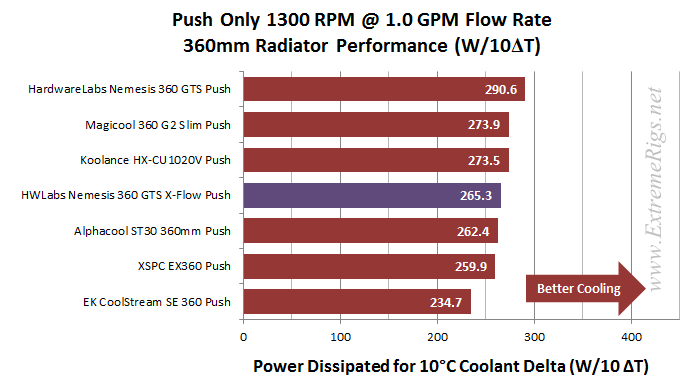
At 1300 RPM Push Only the gap closing to around 9% behind the winner.
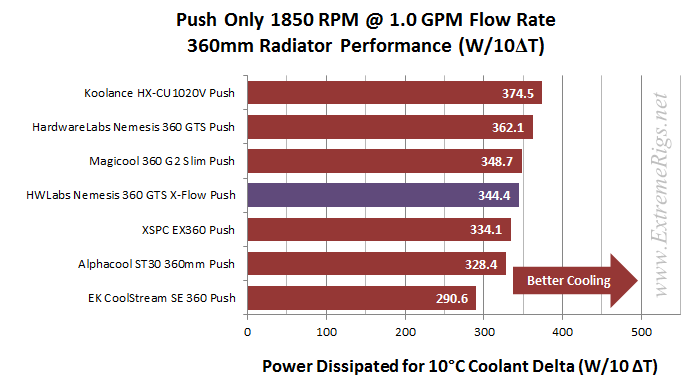 At 1850 Push Only the GTS X-Flow has gained more ground on its non X-Flow sibling, but the Koolance rad with a super dense 30 FPI core has jumped ahead to take 1st place.
At 1850 Push Only the GTS X-Flow has gained more ground on its non X-Flow sibling, but the Koolance rad with a super dense 30 FPI core has jumped ahead to take 1st place.
So there was an expected and unexplained weak result in Push Only test with low fan speeds, but the performance was decent at medium and high fan speeds
Let’s find out how the GTS X-Flow compared in Push/Pull:
Push/Pull Data vs. Competition
For Push/Pull we have averaged the results from the 3 flow rates at which we tested.
First up the 750rpm:
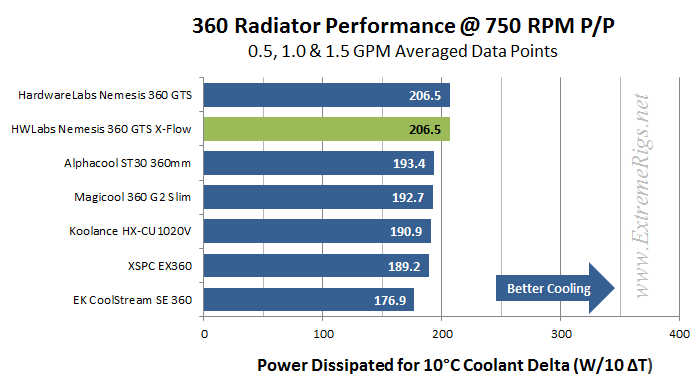 While the Push Only was rather weak, the Push/Pull result was exceptional, placing equal first with the non X-Flow variant of the 360 GTS and is ~6.5% ahead of the nearest competitor.
While the Push Only was rather weak, the Push/Pull result was exceptional, placing equal first with the non X-Flow variant of the 360 GTS and is ~6.5% ahead of the nearest competitor.
Let’s move to 1300 rpm:
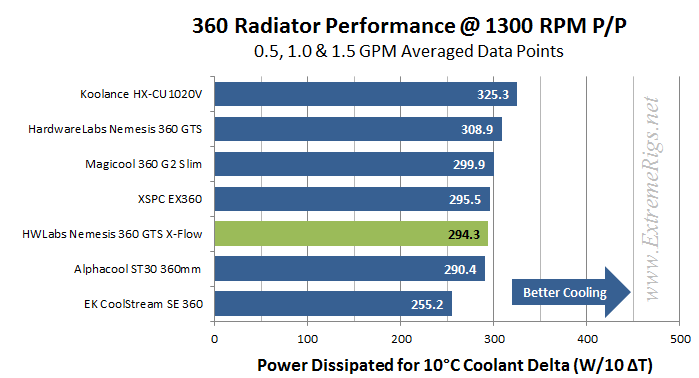 At 1300 the GTS X-Flow takes a drop in the rankings and is ~5% behind the non X-Flow version while the denser core Koolance takes the lead.
At 1300 the GTS X-Flow takes a drop in the rankings and is ~5% behind the non X-Flow version while the denser core Koolance takes the lead.
Now 1850RPM:
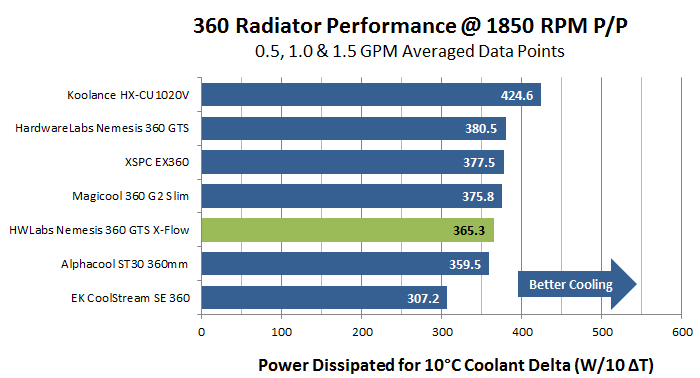
At 1850 Push/Pull the results are similar to those of the 1300rpm.
So the 360 GTS X-Flow had one excellent result, one weak result and was average in the other 4.
Let’s combine the Push Only and Push/Pull results at our 1.0 GPM flow rate into one plot for each fan speed tested.
Again the 750 rpm first:
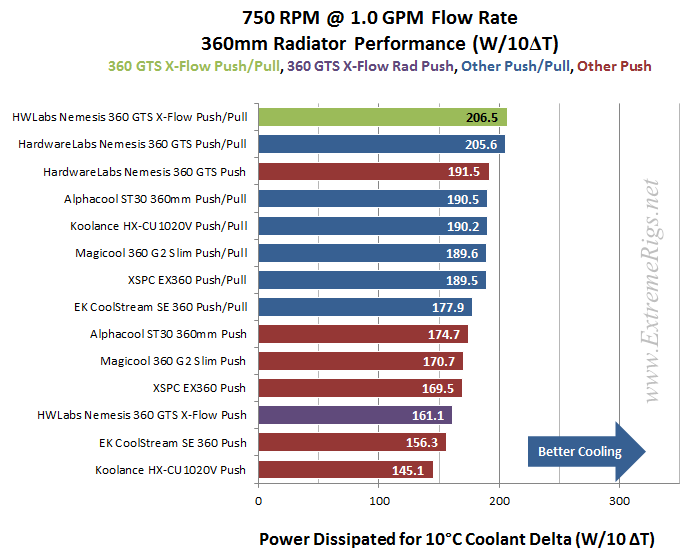
At 750 rpm we see the GTS X-Flow’s best and worst result on the same plot!
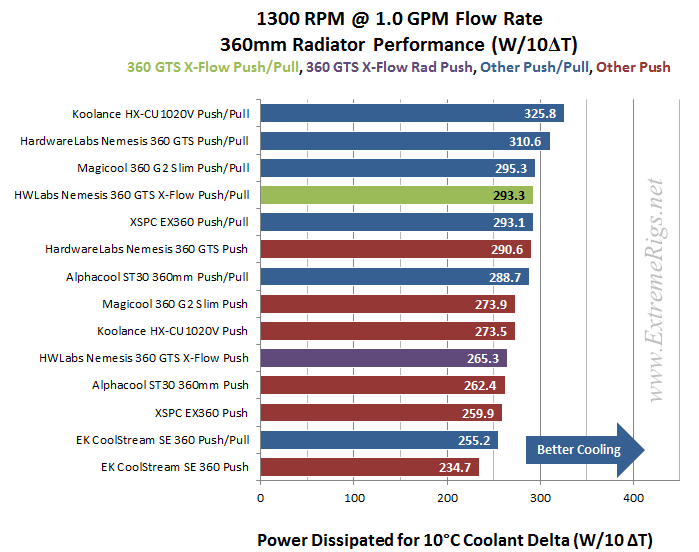
At 1300 and 1850 rpm everything looks in order given the data we’ve already reviewed.
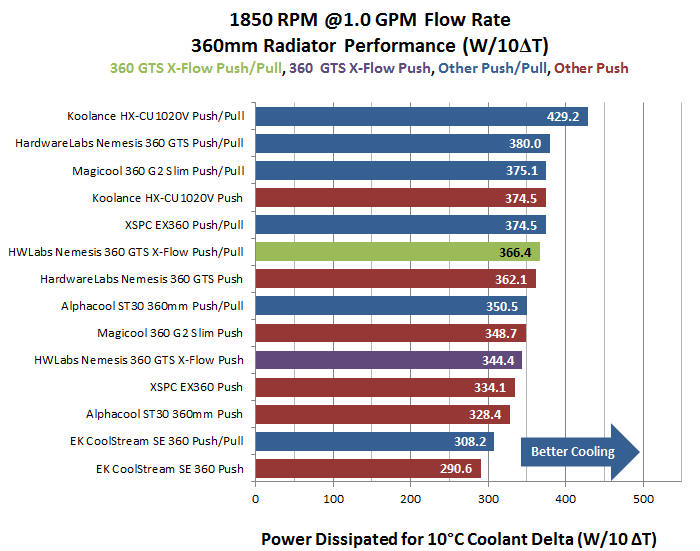
From all of test results we created “Average Performance Factor” charts for both Push Only and Push/Pull and then a combined plot called the “Master Performance Factor”. The radiator with the best cooling ability (W/10ΔT) at each gpm/rpm combo was awarded a score of 100, and each other radiators W/10ΔT result was scored as percentage of the top performer.
This way of looking at the comparison takes away any advantages that a radiator may have at higher or lower fan speeds and looks at an overall average. While this appears fair it does tend to favor those radiators that are all-rounders and those radiators which do very well at high RPM. Most users should be more focused on their specific use case. Check in the Round Up for performance comparisons at every gpm/rpm combo for even more details and cross comparison results.
Here is the Nemesis 360 GTS X-Flow’s Push/Pull percentage scores at each data point that thermal tests were conducted at and additionally the 1.0 gpm Push Only percentages relative to the winner at each fan speed.
This show the excellent results of the GTS X-Flow in Push/Pull at low fan speeds (comparative to the other slims), in addition to the very weak result for the same fan speed in Push Only.
The percentage numbers in the table offer another way of looking at the GTS X-Flow’s results comparatively and how it performed, but for our scoring system we need a way to reduce the categories while retaining the data. To do this we average the results for each fan assembly type giving us Averaged Performance Factors for Push Only, Push/Pull and finally an average of everything in the Master Averaged Performance Factor.
Firstly – the Push Only APF:
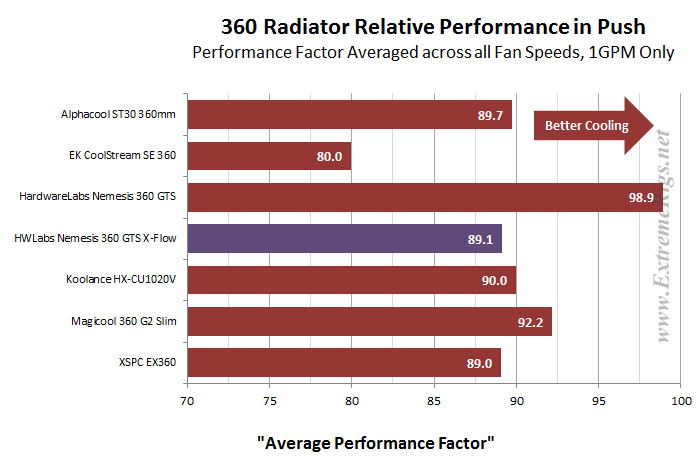 The very weak low fan speed result really dragged down its average. We can see a clear winner and loser with the other 5 rads being tightly bunched within ~3% of each other.
The very weak low fan speed result really dragged down its average. We can see a clear winner and loser with the other 5 rads being tightly bunched within ~3% of each other.
Let’s also take a look at how the Nemesis 360 GTS X-Flow compared in Push Only against all the 360mm radiators we have tested.
Now the Push/Pull APF:
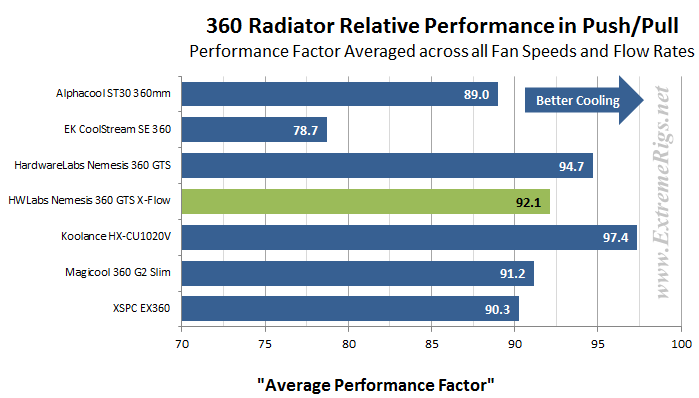 The excellent results in Push/Pull with low speed fans boosted the GTS X-Flow’s average and it placed in 3rd position, ~5% behind the top spot and only 3% behind the regular GTS.
The excellent results in Push/Pull with low speed fans boosted the GTS X-Flow’s average and it placed in 3rd position, ~5% behind the top spot and only 3% behind the regular GTS.
Finally we created the Master Performance Factor which is calculated from the averaged results of all the thermal tests, Push and Push/Pull at all flow rates and all fan speeds.
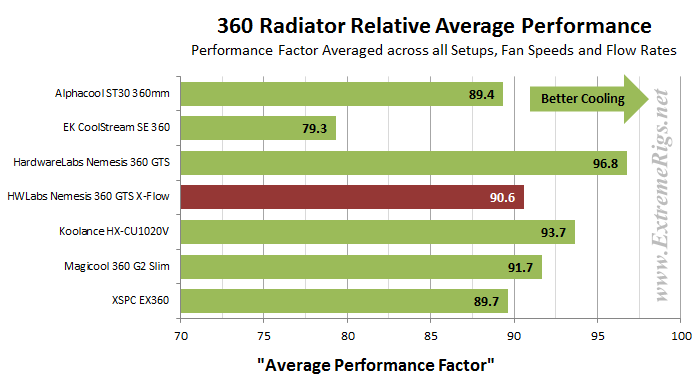
In the Slims Only Master Performance Factor comparisons the Nemesis 360 GTS X-Flow finishes in fourth place. While the non X-Flow version obviously has the better overall averaged thermal performance it is clear that the altered flow pattern and reduced pressure of the X-Flow tube configuration has not significantly impacted on the thermal performance. I would speculate that many users would gladly choose the lower restriction at the cost of slightly lower thermal performance between the two models.
The all encompassing 360mm Radiator MPF!
Next up – Summary!







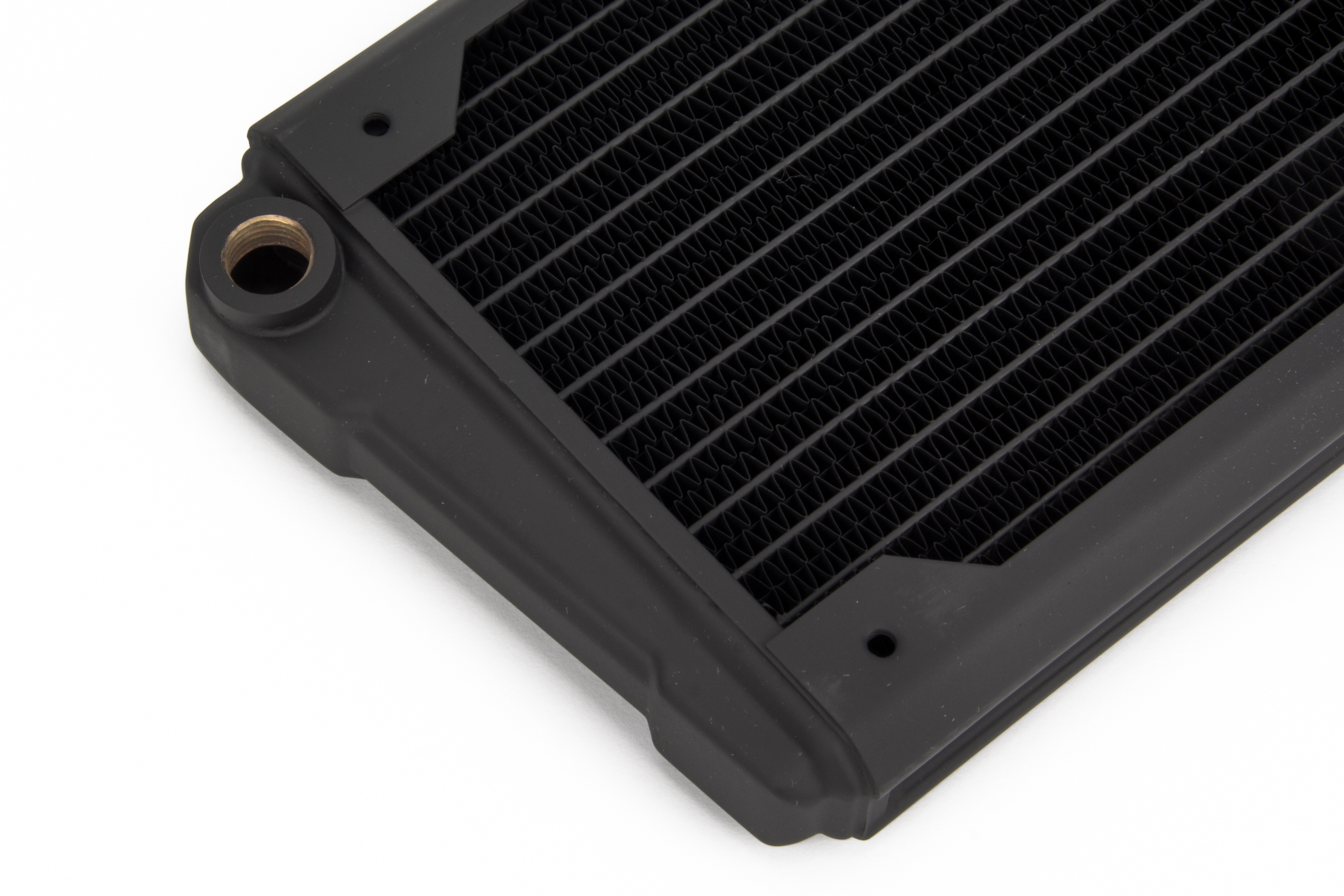
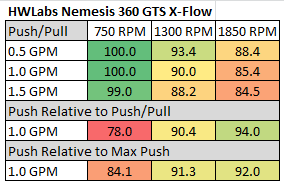
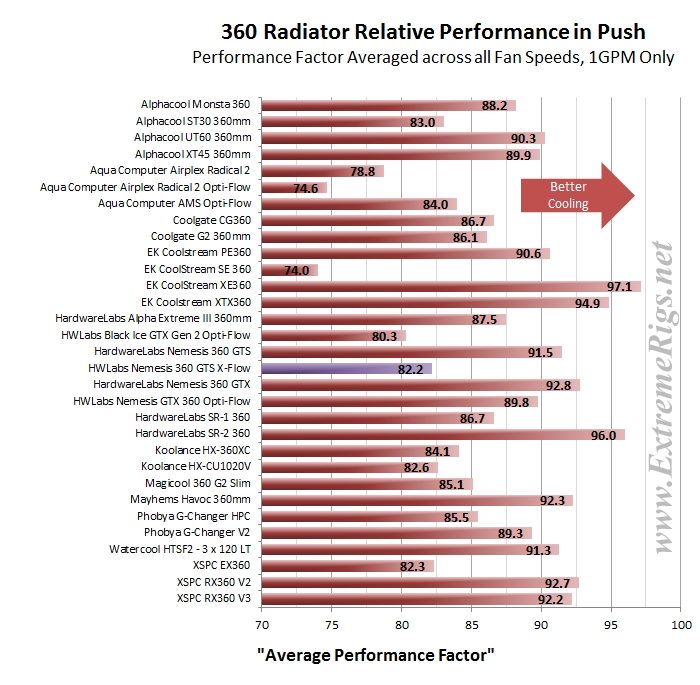
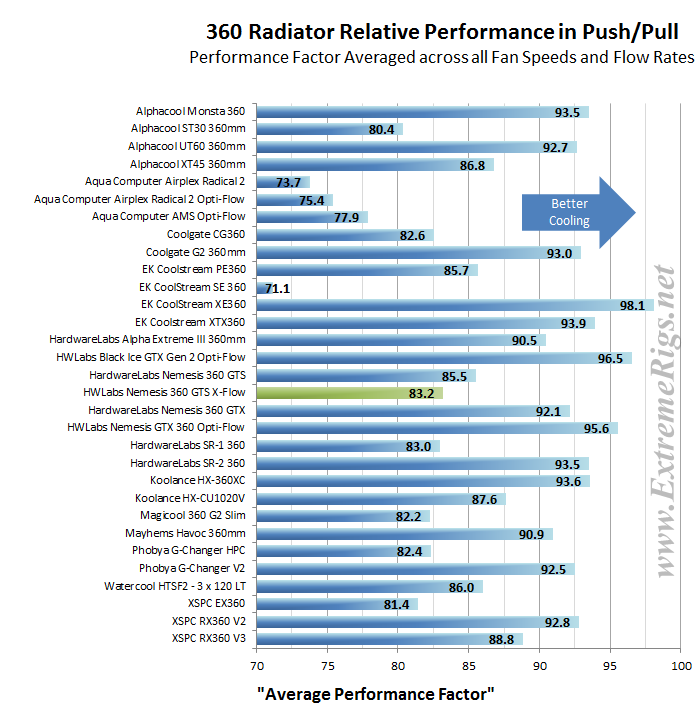
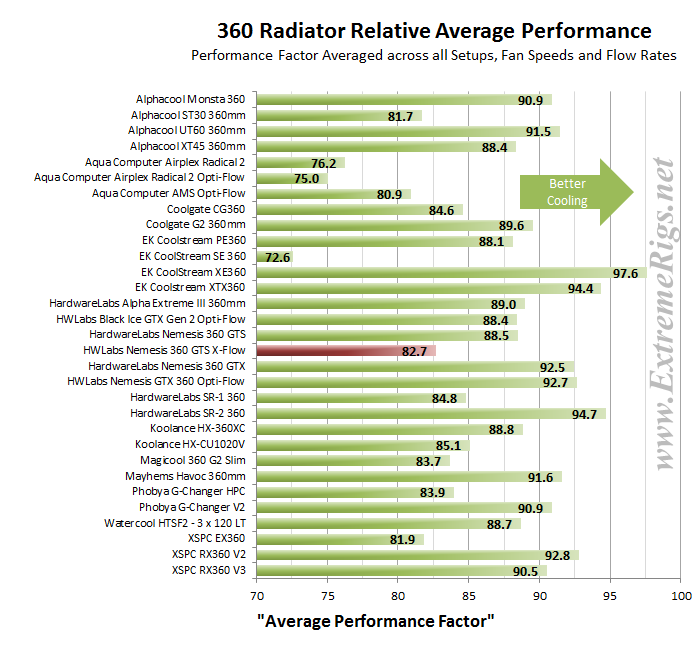
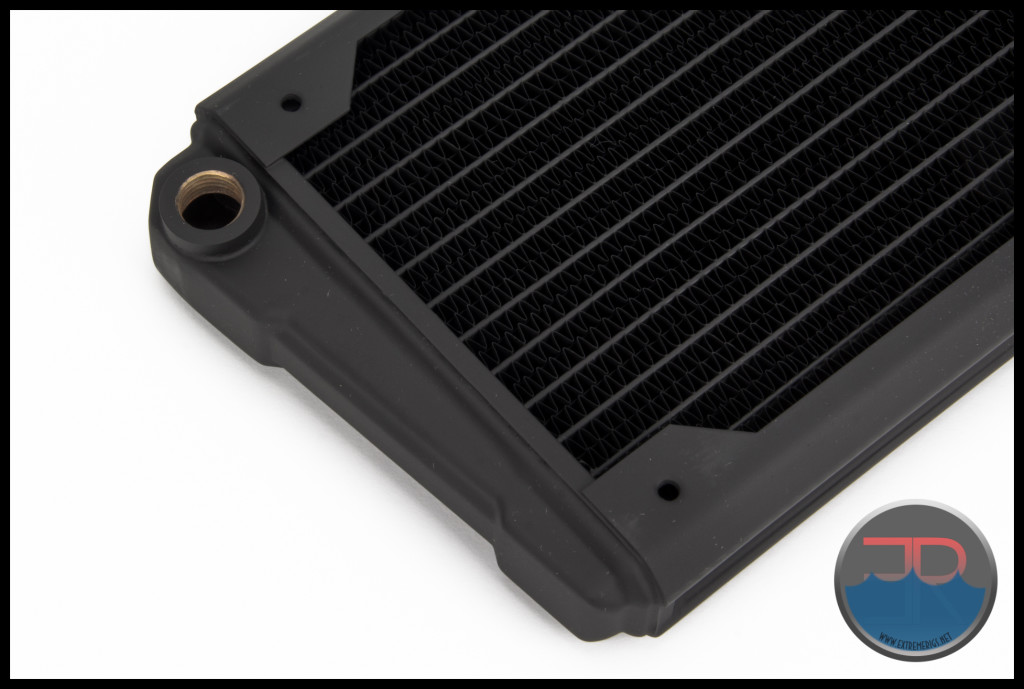



Thank you (again) for doing such a great review. I love these data driven reviews that you guys do.
I recently bought a Black Ice Nemesis 360 GTS U-Flow and Black Ice Nemesis 240 GTS U-Flow. There are in a single loop together with an EK Supremacy EVO X99 and two EK Titan X waterblocks (the GPUs in parallel). So a fairly medium / high flow restriction loop. I also have a dual D5 pump, but as I am currently in the process of tuning my rig I only have 1 pump running. The Flow rate with one D5 on maximum is absolutely fine. The D5 on maximum is also very quiet, so I am lucky there. When I get both pumps up and running I will be able to run the D5s at maybe 40% power each, I imagine, and get satisfactory flow with this set up.
Point being: given this setup I am glad that I have the extra performance of the U-Flow compared to the XFlow. As these radiators are super thin, I am less convinced at the usefulness of push/pull. If you have space for push/pull you could have gone for a 60mm thick rad surely. Also the extra length of the XFlow – as you point out – could cause problems.
Overall I think Hardware Labs radiators are terrific products. Only complaint is the 28mm screw length: I had to buy and then wait for 30mm M4 screws to be delivered to me which held up the whole build.
[…] HWLabs Nemesis 360 GTS X-Flow 360mm Radiator Review […]
Comments are closed.